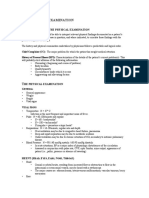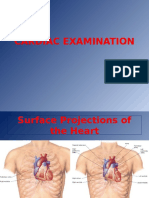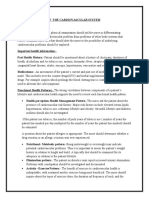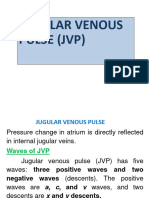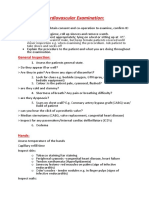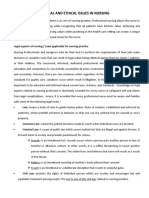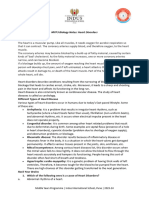0 ratings0% found this document useful (0 votes)
36 viewsCardiovascular Assessment D
Cardiovascular Assessment D
Uploaded by
avinash dhameriyaThis document provides an overview of cardiovascular assessment, including:
1. Describing the anatomy and physiology of the cardiovascular system and objectives of cardiovascular assessment.
2. Outlining the process of cardiovascular examination, including health history, physical assessment, diagnostic studies, and assessment of both cardiovascular function and structure.
3. Detailing specific assessment techniques for various components of the cardiovascular system like inspection and palpation of the neck, jugular veins, precordium, and auscultation of heart sounds.
Copyright:
© All Rights Reserved
Available Formats
Download as DOCX, PDF, TXT or read online from Scribd
Cardiovascular Assessment D
Cardiovascular Assessment D
Uploaded by
avinash dhameriya0 ratings0% found this document useful (0 votes)
36 views8 pagesThis document provides an overview of cardiovascular assessment, including:
1. Describing the anatomy and physiology of the cardiovascular system and objectives of cardiovascular assessment.
2. Outlining the process of cardiovascular examination, including health history, physical assessment, diagnostic studies, and assessment of both cardiovascular function and structure.
3. Detailing specific assessment techniques for various components of the cardiovascular system like inspection and palpation of the neck, jugular veins, precordium, and auscultation of heart sounds.
Original Title
Cardiovascular Assessment d
Copyright
© © All Rights Reserved
Available Formats
DOCX, PDF, TXT or read online from Scribd
Share this document
Did you find this document useful?
Is this content inappropriate?
This document provides an overview of cardiovascular assessment, including:
1. Describing the anatomy and physiology of the cardiovascular system and objectives of cardiovascular assessment.
2. Outlining the process of cardiovascular examination, including health history, physical assessment, diagnostic studies, and assessment of both cardiovascular function and structure.
3. Detailing specific assessment techniques for various components of the cardiovascular system like inspection and palpation of the neck, jugular veins, precordium, and auscultation of heart sounds.
Copyright:
© All Rights Reserved
Available Formats
Download as DOCX, PDF, TXT or read online from Scribd
Download as docx, pdf, or txt
0 ratings0% found this document useful (0 votes)
36 views8 pagesCardiovascular Assessment D
Cardiovascular Assessment D
Uploaded by
avinash dhameriyaThis document provides an overview of cardiovascular assessment, including:
1. Describing the anatomy and physiology of the cardiovascular system and objectives of cardiovascular assessment.
2. Outlining the process of cardiovascular examination, including health history, physical assessment, diagnostic studies, and assessment of both cardiovascular function and structure.
3. Detailing specific assessment techniques for various components of the cardiovascular system like inspection and palpation of the neck, jugular veins, precordium, and auscultation of heart sounds.
Copyright:
© All Rights Reserved
Available Formats
Download as DOCX, PDF, TXT or read online from Scribd
Download as docx, pdf, or txt
You are on page 1of 8
1.
CARDIOVASCULAR ASSESSMENT D. Safaa eidJ. Borrero 9/10 1
2. 2. LECTURE OBJECTIVES1. Review anatomy & physiology of the
cardiovascular system.2. Describe physical assessment of cardiovascular
status.3. Review diagnostic procedures 2
3. 3. CARDIOVASCULAR EXAMINATIONPart I: Assessment of cardiovascular
function Health historyPhysical
assessmentInspectionPalpationPercussionAuscultationLaboratory testCardiac
enzymeLipid profileCoagulation studies
4. 4. • Part II: Assessment of cardiovascular structure• Diagnostic studies• ECG•
Echocardiography• X- ray• The exercise stress• Cardiac catheterization
5. 5. Anatomy & PhysiologyFunctions of the heart & CV system• Pumps blood to
tissues to supply O2 & nutrients• Remove CO2 & metabolic wastes 5
6. 6. Circulation in the Heart1. Oxygen-poor blood(shown in blue) flows fromthe
body into the right atrium.2..Blood flows through theright atrium into the
rightventricle.3. The right ventricle pumpsthe blood to the lungs, wherethe blood
releases wastegases and picks up oxygen.
7. 7. 3. The newly oxygen-rich blood (shown in red) returns to the heart and enters
the left atrium.4. Blood flows throughthe left atrium into the leftventricle.5. The left
ventriclepumps the oxygen-richblood to all parts of thebody.
8. 8. Coronary Circulation
9. 9. Coronary Blood Flow
10. 10. Valves of the Heart• Tricuspid – Directs the flow of blood from the right atrium
to the left ventricle.• Mitral Valve – Directs the flow of blood from the left atrium to
the left ventricle.• Pulmonic (semilunar) – Lies between the right ventricle and the
pulmonary artery.• Aortic Valve (semilunar) – Lies between the left ventricle and
the aortic artery.
11. 11. Part I: Assessment of cardiovascular function physical assessment
12. 12. 1. Health history• a- Socio - cultural history: -• Age, sex, occupation,
educational level, marital status• b- Patient history:-• Past medical history , Past
surgical history• C-Family History• d- Psychosocial Profile
13. 13. - Symptom Analysis• 1- Chest Pain• - Location: - Substernal, pericardial
diffuse, localized• - Radiation: -Radiates to jaw, arm, neck• - Character: - Dull,
aching, pressure, burning tightness, crushing• - Intensity: - Mild, moderate,
severe• - Onset: - Sudden, gradual• - Duration: - 1 -10, more than 15 min, or
continuous• - Precipitating factors: - exercise, motion, eating• - Relieving factors:
- rest, walking, warmth, drugs• - Accompanying symptoms : -dyspnea,
restlessness, sweating, vomiting, cough, syncope, fatigue
14. 14. Pain Assessment Techniques• The patients self-reported pain is often
measured by using pain scales• Numeric Pain Intensity Scale uses a 0-10 scale
to assess the degree of pain. Simple Description Intensity Scale, uses such
words as "mild", "moderate", and "severe" to describe the patients pain intensity.
15. 15. • Visual Analog Scale (VAS) requires patients to mark a point on a 10 cm
horizontal or vertical line to indicate their pain intensity, with• 0 indicating "no
pain“• and 10 indicating "the worst possible pain".
16. 16. Substernal or 5-15min Usually related Rest,retrosternal pain to exertion,
nitroglycerin,spreading across emotion, eating, oxygenchest; may radiate to
coldinside of arm, neck,or Angina Pectoris jaw
17. 17. MI Substernal pain or pain >15 Occurs Morphine over precordium; may min
spontaneo sulfate, spread widely usly but successful throughout chest. Pain may
be reperfusion in shoulders and handsMyocardial Infarction sequela to of
blockedAngina Pectoris may be present. unstable coronary angina artery
18. 18. Esophageal Pain Substernal pain; 5–60 Recumbency, Food, antacid. may be
projected min cold liquids, Nitro-glycerin around chest toAngina Pectoris
exercise. relieves Spasm. shoulders. May occur Spontaneously .
19. 19. anxietyPain over chest; may 2–3 min Stress, Removal ofbe variable. Does
not emotional stimulus, radiate. Patient may tachypnea relaxation complain of
numbness andtingling of hands and mouth.
20. 20. • 2- Palpitations• 3- Syncope• Syncopal attacks (dizziness) are another
symptom that may signal cardiovascular problems.• 4- Edema• Edema may be
seen with right-sided CHF and vascular disease.
21. 21. • Pitting edema is a depression in the skin from pressure.• To demonstrate
the presence of pitting edema, the nurse presses firmly with his or her thumb
over a bony surface• The severity of edema is described on a five-point scale,
from none (0) to very marked (4).
22. 22. • 1+ Mild pitting, slight indentation, no perceptible swelling of the leg• 2+
Moderate pitting, indentation subsides rapidly• 3+ Deep pitting, indentation
remains for a short time, leg looks swollen• 4+ Very deep pitting, indentation lasts
a long time, leg is very swollen
23. 23. • 5- Fatigue• fatigue is associated with cardiovascular disease.• 6- Extremity
Changes• Changes in the extremities may provide clues about underlying
cardiovascular disease. Symptoms such as Paresthesia (numbness, tingling),
coolness, and intermittent claudication (pain in calves during ambulation) may be
associated with vascular disease, coronary heart disease, or cerebral vascular
disease.
24. 24. • 7- Dyspnea and Cough• Dyspnea may also occur with cardiac disease such
as left-sided CHF.
25. 25. B- Physical assessment• General Appearance• Vital Signs• Height and
Weight
26. 26. Inspection and palpation1-Skin• Color• Turgor• Temperature and moisture:-
27. 27. • 2- Nails• Nails should be assessed for color, shape, thickness, symmetry,
and adherence.• Normal nail color is some variation of pink• Nail thickness
generally is 0.3 to 0.65 mm, but it may be thicker in men
28. 28. • Nail abnormalities:-• -Peripheral vascular disease can produce nail
depression,• Clubbing
29. 29. • -Clubbing of the fingers is associated with decreased oxygen.• In clubbing,
the distal tips of the fingers become bulbous, the nails are thickened hard, and
curved at the tip, and the nail bed feels boggy when squeezed.• - Separation
from the nail bed produces a white, yellowish, or greenish color on the non-
adherent portion of the nail.
30. 30. • Capillary refill time:• is a quickly test to assess the adequacy of circulation in
an individual with poor cardiac output. An area of skin is pressed firmly by (say) a
fingertip until it becomes white; the number of seconds for the area to turn pink
again indicates capillary refill time. Normal capillary refill takes around 2 seconds.
31. 31. 2- Inspection and palpation• 1- Inspection of neck
32. 32. • Inspecting the carotid artery and jugular venous system• With the patient in
a supine position, inspect the carotid and jugular venous systems in the neck for
pulsations.• To visualize external venous pulsations, look for pulsations in the
supraclavicular area.
33. 33. • To visualize internal venous pulsations, look for pulsations at the
suprasternal notch.• Using a penlight to cast a shadow on the neck vessels may
help you visualize the pulsations• Carotids have visible pulsation, jugulars have
undulated wave.
34. 34. • Carotids not affected by respirations, jugulars are.• Carotids not affected by
position, jugulars normally only visible when client is supine.• Large, bounding
visible pulsation in neck of at suprasternal notch: HTN, aortic stenosis,.
35. 35. Measuring Jugular Venous Pressure• -Position patient with the head of bed
at 30 to 45-degree angle.• - Place a ruler vertically, perpendicular to the chest at
the angle of Louis (sternal angle).
36. 36. • -identify the highest level of the jugular vein pulsation; if unable to see
pulsations, use the highest level of jugular vein distension.• - Place another ruler
horizontally at the point of the highest level of the venous pulsation.
37. 37. • - Measure the distance up from the chest wall.• The normal JVP is less than
3 cm. A central venous pressure can be estimated by adding 5 cm to the JVP
38. 38. • Elevated JVP: Right-sided CHF, constrictive pericarditis, tricuspid stenosis,
or superior vena cava obstruction.• Low JVP: Hypovolemia.
39. 39. Palpation• Palpating the Carotid
40. 40. • -Lightly palpate each carotid separately.• - Note rate, rhythm, amplitude,
contour, symmetry, elasticity, thrills.
41. 41. Palpating the Jugulars• Palpate jugular veins and check direction of fill.•
Occluding under the jaw, the jugular should flatten, but the wave form become
more prominent.• Occluding above the clavicle, the jugular normally distends
42. 42. • Palpating the Precordium• - Identify and palpate each cardiac site for
pulsations, and thrills:• - Apex (left ventricular area), or mitral area fifth
intercostals space, midclavicular line.
43. 43. • - Base right (aortic area), second intercostals space right sternal border.
44. 44. • - LLSB (tricuspid area), fourth to fifth intercostal space at left sternal border.
45. 45. • - Base left (pulmonic area), second intercostal space left sternal border. -
Listen at each site with both the bell and the diaphragm.
46. 46. - Listen at each site with both the bell and the diaphragm.
47. 47. PALPATION• Impulses - finger pads• Thrills (vibrations palpated secondary
to a murmur—turbulent blood flow through a heart valve) - Bony part of hand, ball
of hand
48. 48. • Thrills are palpable vibrations created by turbulent blood flow.• Lifts or
heaves are diffuse, lifting impulses.• A thrust is a rocking movement.
49. 49. AUSCULTATION• Diaphragm – medium and high frequency sounds• Bell –
low frequency sounds• Normally hear closure of valve Sounds from left side of
heart louder than equivalent sounds from right side of heart
50. 50. • S1 – closure of mitral and tricuspid valves• S2 – closure of aortic and
pulmonic valves• Low pitched sounds S3, S4, mitral stenosis
51. 51. • Right 2nd intercostal space Aortic Area• Left 2nd intercostal space
Pulmonic Area• Left lower sternal border Tricuspid area• Apex – over apical
impulse Mitral area
52. 52. Landmarks
53. 53. • the aortic and pulmonic areas are correlated anatomically with the base of
the heart.
54. 54. • S3 (also called a ventricular gallop) may be heard in the tricuspid and mitral
areas during the early to mid-diastole following the S2 sound.• S3 is heard well
when the client is in the left lateral recumbent position,
55. 55. • S4 (also called atrial diastolic gallop) may be heard in the tricuspid and
mitral areas during the late phase of diastole, before S1 of the next cardiac
cycle.• S4 is heard well when the client is in the supine position
56. 56. Auscultating the Precordium• Auscultate at apex.• - Note rate, rhythm, extra
sounds, or murmurs.• - Note S1, S2, extra sounds, or murmurs.• - Listen at each
site with both the bell and the diaphragm.
57. 57. Murmurs and Stenosis…• A valve that does not close efficiently, results in the
backflow of blood (i.e., insufficiency or regurgitation).• A valve that does not open
wide enough may cause turbulent backflow secondary to obstruction or
narrowing (i.e., stenosis).
58. 58. Abnormal finding• Irregular rhythm: Arrhythmia.• Accentuated S1: High-output
states, mitral or tricuspid stenosis.• Diminished S1: First-degree heart block,
CHF, CAD.• -Variable S1: Atrial fibrillation.• S3, low-pitched, early diastolic
sound: CHF.• S4, low-pitched late-diastolic sound: CAD, HTN, MI.
59. 59. Ejection fraction (EF)• The ejection fraction (EF) represents the amount of
blood pumped out of the heart (left ventricle) with each beat. In the healthy heart,
it is around 70%.• An EF below 55% is considered abnormal.
60. 60. CARDIAC CYCLEEKG – A 12 lead EKG is a graphic record of the electrical
forces produced by the heart 64
61. 61. Acute Anteroseptal MI
62. 62. ELECTRODE POSITIONS“LEADS”• Leads measure electrical activity
between 2 points• Movement toward ⊕ electrode causes positive deflection•
Movement away from ⊕ electrode causes negative deflection 67
63. 63. ELECTRODE POSITIONSA 12 Lead EKG shows electrical activityfrom 12
different positions in the heart,concentrating on (L) ventricleA 14 Lead EKG
includes (R) ventricleactivity 68
64. 64. Cardiac output• SV-• CO-• Preload-• Afterload-• Ejection fraction• GOAL is to
maintain adequate MAP so perfusion of oxygenated blood to vital organs occurs
69
65. 65. Stroke Volume (Sv) & Cardiac Output (Co)• SV – amount of blood ejected by
1 ventricle in 1 beat• CO – volume ejected in 1 minControl of SV and HR =
SV&HR are continually adjusted by the body, and are affected by the return of
blood from the tissues (think of exercise)CO = SVxHR 70
66. 66. 71
67. 67. Decreased S1:♥ Slowed ventricular ejection rate/volume♥ Mitral
insufficiency♥ Increased chest wall thickness♥ Pericardial effusion♥
Hypothyroidism11-09 NR 47
68. 68. Decreased S1 (cont.):♥ Cardiomyopathy♥ LBBB♥ Shock♥ Aortic
insufficiency♥ First degree AV block
69. 69. Other Abnormal S1 (cont.):♥ Increased S1: − Increased cardiac output −
Increased A-V valve flow velocity (acquired mitral stenosis, but not congenital
MS)♥ Wide splitting of S1: − RBBB (at tricuspid area) − PVC’s − VT
70. 70. S2:♥ From closure vibrations of aortic and pulmonary valves♥ Often ignored,
but it can tell much♥ Divided into A2 and P2 (aortic and pulmonary closure
sounds)♥ Best heard at LMSB/2LICS♥ Higher pitched than S1--better heard with
diaphragm11-09 NR 47
71. 71. S2 splitting (normal):♥ Normally split due to different impedance of systemic
and pulmonary vascular beds♥ Audible split with > 20 msec difference♥ Split in
2/3 of newborns by 16 hrs. of age, 80% by 48 hours♥ Harder to discern in heart
rates > 100 bpm11-09 NR 47
72. 72. S2 splitting (normal, cont.):♥ Respiratory variation causes ↑ splitting on
inspiration: ↓ pulmonary vascular resistance♥ When supine, slight splitting can
occur in expiration♥ When upright, S2 usually becomes single with expiration11-
09 NR 47
73. 73. S2 splitting (abnormal):♥ Persistent expiratory splitting − ASD − RBBB − Mild
valvar PS − Idiopathic dilation of the PA − WPW11-09 NR 47
74. 74. S2 splitting (abnormal, cont.):♥ Widely fixed splitting − ASD − RBBB
75. 75. S2 splitting (abnormal, cont.):♥ Wide /mobile splitting − Mild PS − RVOTO −
Large VSD or PDA − Idiopathic PA dilation − Severe MR − RBBB − PVC’s
76. 76. S2 splitting (abnormal, cont.):♥ Reversed splitting − LBBB − WPW − Paced
beats − PVC’s − AS − PDA − LV failure
77. 77. Single S2:♥ Single S2 occurs with greater impedance to pulmonary flow, P2
closer to A2♥ Single and loud (A2): TGA, extreme ToF, truncus arteriosus♥
Single and loud (P2): pulmonary HTN!!♥ Single and soft: typical ToF♥ Loud (not
single) A2: CoA or AI11-09 NR 47
78. 78. Extra heart sounds11-09 NR 47
79. 79. S3 (gallop):♥ Usually physiologic♥ Low pitched sound, occurs with rapid filling
of ventricles in early diastole♥ Due to sudden intrinsic limitation of longitudinal
expansion of ventricular wall♥ Makes Ken-tuck-y rhythm on auscultation11-09
NR 47
80. 80. S3 (cont.):♥ Best heard with patient supine or in left lateral decubitus♥
Increased by exercise, abdominal pressure, or lifting legs♥ LV S3 heard at apex
and RV S3 heard at LLSB11-09 NR 47
81. 81. S3 (abnormal):♥ Seen with Kawasaki’s disease-- disappears after treatment♥
If prolonged/high pitched/louder: − can be a diastolic flow rumble indicating
increased flow volume from atrium to ventricle
82. 82. S4 (gallop):♥ Nearly always pathologic♥ Can be normal in elderly or athletes♥
Low pitched sound in late diastole♥ Due to elevated LVEDP (poor compliance)
causing vibrations in stiff ventricular myocardium as it fills♥ Makes “Ten-nes-see”
rhythm11-09 NR 47
83. 83. S4 (cont.):♥ Better heard at the apex or LLSB in the supine or left lateral
decubitus position♥ Occurs separate from S3 or as summation gallop (single
intense diastolic sound) with S311-09 NR 47
84. 84. S4 Associations:♥ CHF!!!♥ HCM♥ severe systemic HTN♥ pulmonary HTN♥
Ebstein’s anomaly♥ myocarditis
85. 85. S4 Associations (cont.):♥ Tricuspid atresia♥ CHB♥ TAPVR♥ CoA♥ AS w/
severe LV disease♥ Kawasaki’s disease
86. 86. Click:♥ Usually pathologic♥ Snappy, high pitched sound usually in early
systole♥ Due to vibrations in the artery distal to a stenotic valve11-09 NR 47
87. 87. Can be associated with:♥ Valvar aortic stenosis or pulmonary stenosis♥
Truncus arteriosus♥ Pulmonary atresia/VSD♥ Bicuspid aortic valve♥ Mitral valve
prolapse (mid-systolic click)♥ Ebstein’s anomaly (can have multiple clicks)11-09
NR 47
88. 88. Does NOT occur w/ supravalvar or subvalvar AS, or calcific valvar AS.11-09
NR 47
89. 89. Whoop (sometimes called a honk):♥ Loud, variable intensity, musical sound
heard at the apex in late systole♥ Classically associated w/ MVP and MR♥ Seen
w/ VSD’s closing w/ an aneurysm, subAS, rarely TR♥ Some whoops evolve to
become systolic murmurs11-09 NR 47
90. 90. Friction rub:♥ Creaking sound heard with pericardial inflammation♥
Classically has 3 components; can have fewer than 3 components♥ Changes
with position, louder with inspiration11-09 NR 47
91. 91. Murmur:♥ Sounds made by turbulence in the heart or blood stream♥ Can be
benign (innocent, flow, functional) or pathologic♥ Murmurs are the leading cause
for referral for further evaluation♥ Don’t let murmurs distract you from the rest of
the exam!!11-09 NR 47
92. 92. Laboratory tests• Creatine kinase (CK) and its isoenzyme CK-MB• Lactic
dehydrogenase• Troponin I• as low-density lipoproteins (LDL) and high-density
lipoproteins (HDL).
93. 93. • Cholesterol (normal level, less than 200 mg/dL)• LDL (normal level, less
than 130 mg/dL) • HDL (normal range in men, 35 to 65 mg/dL; in women, 35to 85
mg/dL) have a protective action• Triglycerides (normal range, 40 to 150 mg/dL),
composed of free fatty acids and glycerol, are stored in the adipose tissue and
are a source of energy
94. 94. • Coagulation Studies• Partial thromboplastin time (PTT)• Prothrombin time
(PT)
95. 95. • Chest x-ray and fluoroscopy• Electrocardiography
96. 96. Diagnostic Procedures1. EKG 12 Lead continuous cardiac monitoring holter
monitor2. Chest x-ray – detects enlargement of heart & pulmonary congestion
101
97. 97. Diagnostic procedures3. Echocardiography – ultrasound that reveals size,
shape and motion of cardiac structures Evaluates heart wall thickness, valve
structure, differentiates murmurs4. TEE – transesophageal echocardiography
provides a clearer image because less tissue for sound waves to pass through
102
98. 98. Diagnostic procedures5. Angiography / cardiac catherization determines
coronary lesion size, location, evaluate (L) ventricular function, measures heart
pressures6. Exercise tolerance test7. Radionuclide Imaging 103
99. 99. Lab StudiesCardiac enzymes = enzymes are released when cells are
damaged (MI). Enzymes are found in many tissues/muscles, and some are
specific to cardiac tissue. 104
100. 100. Cardiac enzymes = CPK – MB (CK-MB),myoglobin, Troponin In
general, the greater the rise in the serum level of an enzyme, the greater the
degree or extent of damage to the muscle.LDH
101. 101. LAB studies2. Electrolytes3. Lipid panel4. CBC5. C – Reactive
Protein6. BNP- Human B-Natriuretic Peptide7. Blood coags-PT/PTT/INR 106
102. 102. Cholesterol Level : AHA Recommendation• Total Cholesterol – < 200
mg/dL • best – 200 – 239 • borderline high – 240 mg/dL and above • 2X risk of
CAD
103. 103. Cholesterol Level : AHA Recommendation• HDL Cholesterol – < 40
mg/dL (men) – < 50 mg/dL (women) – > 60 mg/dL • cardioprotective
104. 104. Cholesterol Level : AHA Recommendation• LDL Cholesterol – < 100
mg/dL • Optimal – 100 – 129 mg/dL • Near or above optimal – 130 – 159 mg/dL •
Borderline – 160 – 189 mg/dL • High – 190 mg/dL • Very high
105. 105. Cholesterol Level : AHA Recommendation• Triglyceride – < 150
mg/dL • Normal – 150 – 199 mg/dL • Borderline high – 200 – 499mg/dL • High –
500 mg/dL and above • Very high
106. 106. NCLEX TIMEMary is attending a sophomore level nursing class on
anatomy and physiology. Which statement, if made by Mary, demonstrates a
good understanding of the anatomy and physiology of the heart?A."The heart is
encapsulated by a protective coating called the endocardium.“B."The SA node is
considered the main regulator of heart rate.“C."The left atrium receives
deoxygenated venous blood from all peripheral tissues.“D."Stroke volume is the
amount of blood ejected by the right ventricle during each diastole 111
107. 107. NCLEX TIMEKirsten is completing her graduate clinical rotation in a
large urban teaching hospital in a medical coronary care unit (CCU). Which
observation demonstrates a good understanding of completing a thorough
cardiac examination?• A. In an obese client, an adult cuff size of 12 to 14 cm is
preferable.• B.The carotid artery on the neck is auscultated to assess for the
presence of a bruit.• C.The apical impulse is auscultated over the fifth intercostal
space in the midclavicular line.• D.Palpation is used to determine cardiac size.
112
108. 108. NCLEX TIMEEdward is a 40-year-old white male. He is an
accountant who works on average 11 hours per day. He reports feeling stressed
each day, even with mundane things such as a traffic jam. His father had a
massive myocardial infarction at the age of 48. His mother has a history of
congestive heart failure. He seldom has time to exercise, but does eat balanced
meals when possible, although he does not get to eat three meals a day. Select
all factors that place Edward at risk for heart disease.• A.Family history• B.Age•
C.Coping-stress tolerance• D.Race• E.Occupation 113
You might also like
- Inotropic Drugs: DR S A Jayaratne Dept of PharmacologyDocument21 pagesInotropic Drugs: DR S A Jayaratne Dept of Pharmacologyanojan100% (1)
- Concept Map of Myocardial Infarction PDFDocument2 pagesConcept Map of Myocardial Infarction PDFnursing concept mapsNo ratings yet
- Summary of ECG AbnormalitiesDocument8 pagesSummary of ECG AbnormalitiesChristine Nancy NgNo ratings yet
- EKG Interpretation Algorithm (Including Mean Electrical Axis Changes)Document4 pagesEKG Interpretation Algorithm (Including Mean Electrical Axis Changes)Joyce TingNo ratings yet
- Cardiovascular History Taking and Physical ExaminationsDocument35 pagesCardiovascular History Taking and Physical ExaminationsEndalk AsfawNo ratings yet
- Cardiovascular Assessment (1) - StudentsDocument70 pagesCardiovascular Assessment (1) - Studentsraima ayazNo ratings yet
- CARDIOVASCULAR DISEASES (CVD) - Slides (Autosaved)Document227 pagesCARDIOVASCULAR DISEASES (CVD) - Slides (Autosaved)elijah gitongaNo ratings yet
- Assessment of Cardiovascular 2023 (Final1)Document59 pagesAssessment of Cardiovascular 2023 (Final1)ahmed samirNo ratings yet
- health assessment 7Document42 pageshealth assessment 7badrianursealjumailyNo ratings yet
- Cardiovascular AssessmentDocument73 pagesCardiovascular AssessmentmatthewsarfrazbhattiNo ratings yet
- Assessment of CvsDocument70 pagesAssessment of CvsTouseeq ManzoorNo ratings yet
- Cvs ExaminationDocument21 pagesCvs Examinationwizborrlyzo006No ratings yet
- Cardiovascular Physical Examination.pptxDocument74 pagesCardiovascular Physical Examination.pptxNneoma OsakweNo ratings yet
- 3&4&5-Assessment of Peripheral Vascular SystemDocument43 pages3&4&5-Assessment of Peripheral Vascular SystemKhaled Mohamed AssemNo ratings yet
- 2nd. AssessmentDocument61 pages2nd. AssessmentYunus ElonNo ratings yet
- CARDIOVASCULERDocument45 pagesCARDIOVASCULERshortylesleythopoNo ratings yet
- Cardiovascular Assessment-1Document60 pagesCardiovascular Assessment-1M Razzaq100% (1)
- Heart & Neck Vessels Assessment: Kousar Perveen Assistant Professor The University of LahoreDocument43 pagesHeart & Neck Vessels Assessment: Kousar Perveen Assistant Professor The University of LahoreChenii RoyNo ratings yet
- Lecture Three Pulse and ABPDocument33 pagesLecture Three Pulse and ABPas065787No ratings yet
- Ntroduction To The Physical ExaminationDocument4 pagesNtroduction To The Physical ExaminationAngelica NenitaNo ratings yet
- Presentation B. INGGRIS FIKS BUK PUPUTDocument52 pagesPresentation B. INGGRIS FIKS BUK PUPUTRosy OktaridaNo ratings yet
- Assessment of Caridovascular SysDocument36 pagesAssessment of Caridovascular Syssceince with EZNo ratings yet
- Health Assessment SAS Session 13 PDFDocument8 pagesHealth Assessment SAS Session 13 PDFMaria Jub MangrubanNo ratings yet
- CardiacassessmentDocument40 pagesCardiacassessmentsasNo ratings yet
- Physical DiagnosisDocument63 pagesPhysical Diagnosishailemariamgebrehiwot02No ratings yet
- Critical Care MedicineDocument47 pagesCritical Care MedicineNagendra VermaNo ratings yet
- Cardiac ExaminationDocument21 pagesCardiac ExaminationPraneetha NouduriNo ratings yet
- Cardiac AssessmentDocument11 pagesCardiac Assessmentwaqas_xsNo ratings yet
- CVS ExaminationDocument72 pagesCVS ExaminationDivya JyothiNo ratings yet
- CVS Disorder (MR VINIL)Document769 pagesCVS Disorder (MR VINIL)Rebira WorkinehNo ratings yet
- Cardiac ExaminationDocument23 pagesCardiac ExaminationAreza Eka PermanaNo ratings yet
- History and Exam 3rd Level, 3Document15 pagesHistory and Exam 3rd Level, 3monstersamaqNo ratings yet
- Cardiovascular Assessment-Part 1Document32 pagesCardiovascular Assessment-Part 1Nezar AlnasserNo ratings yet
- 11 CVS Examination IDocument44 pages11 CVS Examination Isanhori159753No ratings yet
- History and exam 3rd level,3Document15 pagesHistory and exam 3rd level,3omaralhasani2003No ratings yet
- Assessment of Cardiovascular SystemDocument5 pagesAssessment of Cardiovascular SystemAnamika ChoudharyNo ratings yet
- Heart AssessmentDocument44 pagesHeart Assessmentyoeljoseph654No ratings yet
- Examination and Investigation of The Cardiovascular System (CVS)Document27 pagesExamination and Investigation of The Cardiovascular System (CVS)Jake MillerNo ratings yet
- Cardiac Exam (17-10-2021)Document30 pagesCardiac Exam (17-10-2021)MinaNo ratings yet
- Cardiovascular SystemDocument53 pagesCardiovascular Systemmehakapoor29No ratings yet
- Cardiovascular ExamDocument29 pagesCardiovascular Exammeging438No ratings yet
- Osce Notes - Rac - Safina AdatiaDocument35 pagesOsce Notes - Rac - Safina AdatiaTraventure 2000No ratings yet
- Local Exam 5Document68 pagesLocal Exam 5drnasir31No ratings yet
- Health Assessment: Mae - Joanne M. Bongat, MANDocument253 pagesHealth Assessment: Mae - Joanne M. Bongat, MANseph bron100% (1)
- Cardiovascular SystemDocument44 pagesCardiovascular SystemGatar Alnada AlhabibNo ratings yet
- Assessment of Cardiovascular2014Document12 pagesAssessment of Cardiovascular2014alphabennydelta4468No ratings yet
- HeartDocument35 pagesHeartMehreen SaeedNo ratings yet
- Presentation, Symptoms and Signs of Heart Failure: What Will I Learn?Document5 pagesPresentation, Symptoms and Signs of Heart Failure: What Will I Learn?Vidini Kusuma AjiNo ratings yet
- Assessment Cardiac SystemDocument51 pagesAssessment Cardiac Systemejarnmd100% (2)
- Ha Lec 12 13Document23 pagesHa Lec 12 13Althea Sachi CruzNo ratings yet
- Cardiovascular System Physical Examination ApproachDocument41 pagesCardiovascular System Physical Examination Approachlampido90No ratings yet
- Cardiology Part PX FisikDocument36 pagesCardiology Part PX FisikNC DieselNo ratings yet
- Cardiac SheetDocument15 pagesCardiac SheetKhansa SheikhNo ratings yet
- CVS ExaminationDocument72 pagesCVS ExaminationPrashanthBhatNo ratings yet
- JVP, Hs&coDocument29 pagesJVP, Hs&coVansh SinghNo ratings yet
- Vascular ExaminationDocument40 pagesVascular Examinationminhkhanh30081999No ratings yet
- 5+2 Chest PainDocument27 pages5+2 Chest PainMazen HossamNo ratings yet
- Heart: - Divided by A Vertical Septum Into Four (4) ChambersDocument32 pagesHeart: - Divided by A Vertical Septum Into Four (4) ChambersRoger ViloNo ratings yet
- ASSESSMENT OF CARDIOVASCULER SYSTEMDocument52 pagesASSESSMENT OF CARDIOVASCULER SYSTEMRaheem MohsinNo ratings yet
- Health Assessment - Cardiac & PVSDocument56 pagesHealth Assessment - Cardiac & PVSclaire3230No ratings yet
- New HematologyOncology FAE2016Document108 pagesNew HematologyOncology FAE2016omarNo ratings yet
- Cardiovascular Examination:: General InspectionDocument6 pagesCardiovascular Examination:: General InspectionPhysician AssociateNo ratings yet
- Cardiovascular System_Physical Dx_10 March 2015 (1)Document46 pagesCardiovascular System_Physical Dx_10 March 2015 (1)asayeelias9No ratings yet
- Immediate Life Support for healthcare Practitioners: A Step-By-Step GuideFrom EverandImmediate Life Support for healthcare Practitioners: A Step-By-Step GuideNo ratings yet
- Embryology of Heart and LungDocument7 pagesEmbryology of Heart and Lungavinash dhameriyaNo ratings yet
- Congestive Cardiac FailureDocument36 pagesCongestive Cardiac Failureavinash dhameriyaNo ratings yet
- Nursing TheoriesDocument5 pagesNursing Theoriesavinash dhameriyaNo ratings yet
- Curriculum Sarika MamDocument39 pagesCurriculum Sarika Mamavinash dhameriyaNo ratings yet
- Assessment On RSDocument13 pagesAssessment On RSavinash dhameriyaNo ratings yet
- Genetic CounsellingDocument3 pagesGenetic Counsellingavinash dhameriyaNo ratings yet
- Remember: Goals and Plan of Care Should Be Base According To Client's Problems/needs NOT According To Your OwnDocument11 pagesRemember: Goals and Plan of Care Should Be Base According To Client's Problems/needs NOT According To Your Ownavinash dhameriyaNo ratings yet
- Curriculum Research in Nursing-Lesson PlanDocument13 pagesCurriculum Research in Nursing-Lesson Planavinash dhameriyaNo ratings yet
- Sampling in Quantitative Studies: Basic Sampling Concepts 1. PopulationDocument11 pagesSampling in Quantitative Studies: Basic Sampling Concepts 1. Populationavinash dhameriyaNo ratings yet
- Axillary ArteryDocument7 pagesAxillary Arteryavinash dhameriyaNo ratings yet
- Spinal Cord Injury: Neck ChestDocument4 pagesSpinal Cord Injury: Neck Chestavinash dhameriyaNo ratings yet
- Regulatory Bodies / Apex BodiesDocument6 pagesRegulatory Bodies / Apex Bodiesavinash dhameriyaNo ratings yet
- Osteomalacia: (Eg, Phenytoin, Phenobarbital)Document1 pageOsteomalacia: (Eg, Phenytoin, Phenobarbital)avinash dhameriyaNo ratings yet
- HypothyroidismDocument7 pagesHypothyroidismavinash dhameriyaNo ratings yet
- Diabetes INSIPIDUSDocument6 pagesDiabetes INSIPIDUSavinash dhameriya100% (1)
- HyperthyroidismDocument4 pagesHyperthyroidismavinash dhameriyaNo ratings yet
- Addison's DiseaseDocument3 pagesAddison's Diseaseavinash dhameriyaNo ratings yet
- Inc Code of Ethics For Nurses in IndiaDocument3 pagesInc Code of Ethics For Nurses in Indiaavinash dhameriya100% (2)
- Legal and Ethical Issues in NursingDocument18 pagesLegal and Ethical Issues in Nursingavinash dhameriya100% (2)
- (UMA) ERBA XL-640 Basic Performance DataDocument38 pages(UMA) ERBA XL-640 Basic Performance DataKo KyoNo ratings yet
- EKG - Assignment Without AnswersDocument10 pagesEKG - Assignment Without AnswersJon Millhollon100% (1)
- Theischemic Electrocardiogram: Daniel L. KreiderDocument16 pagesTheischemic Electrocardiogram: Daniel L. KreiderAlejandro Peñaloza TapiaNo ratings yet
- The ECG in Hypothermia - Osborn WavesDocument2 pagesThe ECG in Hypothermia - Osborn WavesVid MirosevicNo ratings yet
- Biology - MYP 3 - 31st AugustDocument6 pagesBiology - MYP 3 - 31st Augustarchit.kulkarni7756No ratings yet
- Chapter 34 - Test QuestionsDocument9 pagesChapter 34 - Test Questionsfriendofnurse100% (4)
- Holter MonitoringDocument19 pagesHolter Monitoringomotola Ayobundle-oyewo MA206100% (2)
- Maxicare Eready Titanium Benefits 1Document3 pagesMaxicare Eready Titanium Benefits 1Bon Anthony TipdasNo ratings yet
- Anesthesia in High-Risk Patients. ISBN 331986937X, 978-3319869377Document23 pagesAnesthesia in High-Risk Patients. ISBN 331986937X, 978-3319869377madonnafiesterk100% (12)
- Srfac CPR (Ho) +aed Manual (2018)Document42 pagesSrfac CPR (Ho) +aed Manual (2018)Perry HengNo ratings yet
- Ebook Echocardiography With SimulationsDocument91 pagesEbook Echocardiography With SimulationsAbdul WaheedNo ratings yet
- Pediatric Dilatated Cardiomyopathy and Congestive Heart FailureDocument2 pagesPediatric Dilatated Cardiomyopathy and Congestive Heart FailureRJMNo ratings yet
- Diagnostic Approach To Chronic Kidney DiseaseDocument3 pagesDiagnostic Approach To Chronic Kidney DiseaseBlomblom Pow00No ratings yet
- Atlas of Nuclear Cardiology Imaging Companion to Braunwald s Heart Disease Expert Consult Online and Print Imaging Techniques to Braunwald s Heart Disease 1st Edition Ami E. Iskandrian Md Macc Faha Fasnc all chapter instant downloadDocument61 pagesAtlas of Nuclear Cardiology Imaging Companion to Braunwald s Heart Disease Expert Consult Online and Print Imaging Techniques to Braunwald s Heart Disease 1st Edition Ami E. Iskandrian Md Macc Faha Fasnc all chapter instant downloadskrevabeleyr100% (4)
- Left Vs Right: Heart FailureDocument3 pagesLeft Vs Right: Heart FailureRosalinda PerigoNo ratings yet
- Osce DefibrillatorDocument2 pagesOsce DefibrillatorchrisNo ratings yet
- World Kidney Day: Grand RoundDocument16 pagesWorld Kidney Day: Grand RoundAhmed AlsayeghNo ratings yet
- B009HQA92MDocument520 pagesB009HQA92Mrama DulalNo ratings yet
- ALS Algorithms LS Tachycardia 2.0Document1 pageALS Algorithms LS Tachycardia 2.0Lucian Alin DinuNo ratings yet
- Advanced Internal Medicine Training Requirements (As at 24 Aug 18) 2Document9 pagesAdvanced Internal Medicine Training Requirements (As at 24 Aug 18) 2leeNo ratings yet
- ACLS Cardiac Arrest Algorithm For Suspected or Confirmed COVID-19 PatientsDocument2 pagesACLS Cardiac Arrest Algorithm For Suspected or Confirmed COVID-19 PatientsDeny PamungkasNo ratings yet
- A Randomized Multicenter Trial On A Lung Ultrasound-Guided Treatment Strategy in Patients On Chronic Hemodialysis With High Cardiovascular RiskDocument9 pagesA Randomized Multicenter Trial On A Lung Ultrasound-Guided Treatment Strategy in Patients On Chronic Hemodialysis With High Cardiovascular RiskMarco Antonio Viera ArevaloNo ratings yet
- CPR SLIDE 2020 GuidelinesDocument45 pagesCPR SLIDE 2020 Guidelinesvmm74m9p22No ratings yet
- Transcatheter Tricuspid Valve Interventions: Landscape, Challenges, and Future DirectionsDocument22 pagesTranscatheter Tricuspid Valve Interventions: Landscape, Challenges, and Future DirectionsgNo ratings yet
- Common MurmurDocument2 pagesCommon MurmurKyWoNo ratings yet
- Heart BlockDocument60 pagesHeart Blockmaibejose100% (1)



















